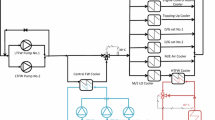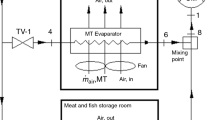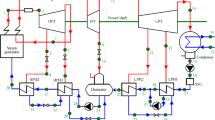Abstract
Ship refrigeration compressors are sized to provide required capacity under extreme atmospheric and sea water temperatures, as well as full load and pulldown rates. Refrigeration compressors usually operate at 50–60 Hz in on/off mode at partial load in cold and temperate sea waters. The most efficient way to meet variable cooling demands is to change refrigerant mass flow by adjusting compressor speed. This paper is based on experimental investigation of ship cold storage refrigeration system on laboratory scale. Compressor is driven by inverter, and condenser is water-cooled type just like on ships. The refrigeration compressor has a power range of 600–1000 W and a maximum power of 1500 W. The system’s refrigeration capacity ranges from 500 to 1350 W, with a maximum capacity of 2000 W. Experimental results were subjected to energy and exergy analyses. At 60 Hz, exergy efficiencies of compressor, condenser, expansion valve, and cold storage are 37.9%, 91.1%, 86.2%, and 69.8%, at − 5 °C cold storage and 18 °C water temperatures. In the same order, they contributed 73.2%, 7.6%, 10.4%, and 7% to wasted power. When water temperature increased from 18 to 35 °C at − 5 °C storage temperature and 50 Hz, coefficient of performance (COP) decreased by 55.2%. Despite compressor's thermodynamic irreversibility decreasing, combined electrical–mechanical efficiency deteriorated as frequency decreased. When compressor frequency was reduced from 60 to 40 Hz at − 5 °C cold storage and 18 °C water temperatures, COP increased by 13.9%.














Similar content being viewed by others
Abbreviations
- f :
-
Frequency (Hz)
- h :
-
Specific enthalpy (J/kg)
- \(\dot{m}\) :
-
Mass flow rate (kg/s)
- p :
-
Pressure (Pa, bar)
- \(\dot{Q}\) :
-
Heat transfer rate (W)
- s:
-
Specific entropy (J/kg °C)
- T :
-
Temperature (°C)
- V :
-
Cylinder volume (m3)
- \(\dot{W}\) :
-
Power (W)
- \({\eta }_{\mathrm{I}}\) :
-
First law efficiency
- \({\eta }_{\mathrm{II}}\) :
-
Exergy efficiency
- υ :
-
Specific volume (m3/kg)
- \(\dot{X}\) :
-
Exergy transfer rate (J/s)
- ψ :
-
Flow exergy (J/kg)
- in:
-
Inlet of components
- o:
-
Dead state
- out:
-
Outlet of components
- ref:
-
Refrigerant
- w:
-
Water
References
Başhan V, Kökkülünk G (2020) Exergoeconomic and air emission analyses for marine refrigeration with waste heat recovery system: a case study. J Mar Eng Technol 19:147–160. https://doi.org/10.1080/20464177.2019.1656324
Dere C, Deniz C (2019) Load optimization of central cooling system pumps of a container ship for the slow steaming conditions to enhance the energy efficiency. J Clean Prod 222:206–217. https://doi.org/10.1016/j.jclepro.2019.03.030
IMO (2021) Highlights and executive summary of the fourth IMO GHG study 2020. International Maritime Organization, London
Cao T, Lee H, Hwang Y et al (2015) Performance investigation of engine waste heat powered absorption cycle cooling system for shipboard applications. Appl Therm Eng 90:820–830. https://doi.org/10.1016/j.applthermaleng.2015.07.070
IMO-MARPOL (2021) International convention for the prevention of pollution from ships. https://www.imo.org/en/About/Conventions/Pages/International-Convention-for-the-Prevention-of-Pollution-from-Ships-(MARPOL).aspx. Accessed 20 Aug 2021
ASHRAE (2010) ASHRAE handbook—refrigeration. American Society of Heating, Refrigerating and Air-Conditioning Engineers, Inc., Atlanta
Fitzgerald WB, Howitt OJA, Smith IJ, Hume A (2011) Energy use of integral refrigerated containers in maritime transportation. Energy Policy 39:1885–1896. https://doi.org/10.1016/j.enpol.2010.12.015
Pigani L, Boscolo M, Pagan N (2016) Marine refrigeration plants for passenger ships: low-GWP refrigerants and strategies to reduce environmental impact. Int J Refrig 64:80–92. https://doi.org/10.1016/j.ijrefrig.2016.01.016
Cao T, Lee H, Hwang Y et al (2016) Modeling of waste heat powered energy system for container ships. Energy 106:408–421. https://doi.org/10.1016/j.energy.2016.03.072
Salmi W, Vanttola J, Elg M et al (2017) Using waste heat of ship as energy source for an absorption refrigeration system. Appl Therm Eng 115:501–516. https://doi.org/10.1016/j.applthermaleng.2016.12.131
Castelein B, Geerlings H, Van Duin R (2020) The reefer container market and academic research: a review study. J Clean Prod 256:120654. https://doi.org/10.1016/j.jclepro.2020.120654
Harbach J (2005) Marine refrigeration and air-conditioning. Cornell Maritime Press, Atglen
Cengel YA, Ghajar AJ (2015) Heat and mass transfer: fundamentals and applications. McGraw-Hill, New York
ASHRAE (2013) ASHRAE handbook—fundamentals. American Society of Heating, Refrigerating and Air-Conditioning Engineers, Inc., Atlanta
Diniz MC, Melo C, Deschamps CJ (2018) Experimental performance assessment of a hermetic reciprocating compressor operating in a household refrigerator under on–off cycling conditions. Int J Refrig 88:587–598. https://doi.org/10.1016/j.ijrefrig.2018.03.024
Li W (2013) Simplified steady-state modeling for variable speed compressor. Appl Therm Eng 50:318–326. https://doi.org/10.1016/j.applthermaleng.2012.08.041
Jolly PG, Tso CP, Wong YW, Ng SM (2000) Simulation and measurement on the full-load performance of a refrigeration system in a shipping container. Int J Refrig 23:112–126. https://doi.org/10.1016/S0140-7007(99)00044-4
Brown E, Colling A, Park D et al (2004) Seawater: its composition, properties and behaviour. Butterworth-Heinemann in Association with the Open University, Oxford
IMO-MEPC (2016) 2016 guidelines for the development of a ship energy efficiency management plan (SEEMP). https://gmn.imo.org/wp-content/uploads/2017/05/MEPC-28270-2017-SEEMP-Guidelines.pdf. Accessed 10 Aug 2021
Perreira EP, Parise JAR (1993) Performance analysis of capacity control devices for heat pump reciprocating compressors. Heat Recover Syst CHP 13:451–461. https://doi.org/10.1016/0890-4332(93)90046-X
Tassou S, Qureshi T (1998) Comparative performance evaluation of positive displacement compressors in variable-speed refrigeration applications. Int J Refrig 21:29–41. https://doi.org/10.1016/S0140-7007(97)00082-0
Aprea C, Renno C (2004) An experimental analysis of a thermodynamic model of a vapour compression refrigeration plant on varying the compressor speed. Int J Energy Res 28:537–549. https://doi.org/10.1002/er.983
Nasution H, Wan Hassan MN (2006) Potential electricity savings by variable speed control of compressor for air conditioning systems. Clean Technol Environ Policy 8:105–111. https://doi.org/10.1007/s10098-006-0040-0
Aprea C, Mastrullo R, Renno C (2009) Determination of the compressor optimal working conditions. Appl Therm Eng 29:1991–1997. https://doi.org/10.1016/j.applthermaleng.2008.10.002
Ekren O, Celik S, Noble B, Krauss R (2013) Performance evaluation of a variable speed DC compressor. Int J Refrig 36:745–757. https://doi.org/10.1016/j.ijrefrig.2012.09.018
Piedrahita-Velásquez CA, Ciro-Velásquez HJ, Gómez-Botero MA (2014) Identification and digital control of a household refrigeration system with a variable speed compressor. Int J Refrig 48:178–187. https://doi.org/10.1016/j.ijrefrig.2014.09.009
Dechesne BJ, Tello-Oquendo FM, Gendebien S, Lemort V (2019) Residential air-source heat pump with refrigerant injection and variable speed compressor: experimental investigation and compressor modeling. Int J Refrig 108:79–90. https://doi.org/10.1016/j.ijrefrig.2019.08.034
Elsayed AO, Kayed TS (2020) Dynamic performance analysis of inverter-driven split air conditioner. Int J Refrig 118:443–452. https://doi.org/10.1016/j.ijrefrig.2020.05.014
Ozsipahi M, Kose HA, Cadirci S et al (2019) Experimental and numerical investigation of lubrication system for reciprocating compressor. Int J Refrig 108:224–233. https://doi.org/10.1016/j.ijrefrig.2019.08.026
Burt CM, Piao X, Gaudi F et al (2008) Electric motor efficiency under variable frequencies and loads. J Irrig Drain Eng 134:129–136. https://doi.org/10.1061/(asce)0733-9437(2008)134:2(129)
Wang G, Han Z (2019) Investigation of the accuracy of VFD analog output data and the energy performance of different voltage controls in a VFD-motor-belt-fan system. Energy Build 194:260–272. https://doi.org/10.1016/j.enbuild.2019.04.008
Koury RNN, Machado L, Ismail KAR (2001) Numerical simulation of a variable speed refrigeration system. Int J Refrig 24:192–200. https://doi.org/10.1016/S0140-7007(00)00014-1
Ust Y, Sinan Karakurt A, Gunes U (2016) Performance analysis of Multipurpose Refrigeration System (MRS) on fishing vessel. Pol Marit Res 23:48–56. https://doi.org/10.1515/pomr-2016-0020
Su P, Ji J, Cai J et al (2020) Dynamic simulation and experimental study of a variable speed photovoltaic DC refrigerator. Renew Energy 152:155–164. https://doi.org/10.1016/j.renene.2020.01.047
Lee C-H, Liu Z-W, Chen C-N et al (2015) Assessment of energy savings with variable speed drives in ship’s cooling pumps. IEEE Trans Energy Convers 30:1288–1298. https://doi.org/10.1109/TEC.2015.2431733
Pariotis, Zannis, Katsanis (2019) An integrated approach for the assessment of central cooling retrofit using variable speed drive pump in marine applications. J Mar Sci Eng 7:253. https://doi.org/10.3390/jmse7080253
Liang Y, Shu G, Tian H et al (2013) Analysis of an electricity-cooling cogeneration system based on RC-ARS combined cycle aboard ship. Energy Convers Manag 76:1053–1060. https://doi.org/10.1016/j.enconman.2013.08.056
Ammar NR, Sediek IS (2018) Thermo-economic analysis and environmental aspects of absorption refrigeration unit operation onboard marine vehicles: Ro-Pax vessel case study. Pol Marit Res 25:94–103. https://doi.org/10.2478/pomr-2018-0100
Kasera S, Nayak R, Chandra Bhaduri S (2021) Performance analysis of solar milk refrigerator using energy efficient R290. Case Stud Therm Eng 24:100855. https://doi.org/10.1016/j.csite.2021.100855
Cebi S, Celik M, Kahraman C, Er ID (2009) An expert system towards solving ship auxiliary machinery troubleshooting: SHIPAMTSOLVER. Expert Syst Appl 36:7219–7227. https://doi.org/10.1016/j.eswa.2008.09.060
Morris AS, Langari R (2012) Measurement and instrumentation: theory and application. Academic Press, San Diego
Cengel YA, Boles MA (2015) Thermodynamics: an engineering approach. McGraw-Hill, New York
Kızılkan Ö, Kabul A, Yakut AK (2010) Exergetic performance assessment of a variable-speed R404a refrigeration system. Int J Energy Res 34:463–475. https://doi.org/10.1002/er.1553
Hundy GH, Trott AR, Welch TC (2008) Refrigeration and air-conditioning. Butterworth-Heinemann, Oxford
Aprea C, Renno C (2009) Experimental model of a variable capacity compressor. Int J Energy Res 33:29–37. https://doi.org/10.1002/er.1468
Shao S, Shi W, Li X, Chen H (2004) Performance representation of variable-speed compressor for inverter air conditioners based on experimental data. Int J Refrig 27:805–815. https://doi.org/10.1016/j.ijrefrig.2004.02.008
Cho H, Chung JT, Kim Y (2003) Influence of liquid refrigerant injection on the performance of an inverter-driven scroll compressor. Int J Refrig 26:87–94. https://doi.org/10.1016/S0140-7007(02)00017-8
Acknowledgements
This work has been supported by Yildiz Technical University Scientific Research Projects Coordination Unit under Project Number 2015-10-02-KAP02. We also would like to thank Mr. Doğan Tuptaş, Hakan Bakır, Kenan Arı, Hüseyin, and İsmet for their assistance in building the experimental setup.
Author information
Authors and Affiliations
Corresponding author
Additional information
Technical Editor: Jader Barbosa Jr.
Publisher's Note
Springer Nature remains neutral with regard to jurisdictional claims in published maps and institutional affiliations.
Rights and permissions
About this article
Cite this article
Yilmaz, O., Bayar, H., Başhan, V. et al. Experimental energy and exergy analyses of ship refrigeration system operated by frequency inverter at varying sea water temperatures. J Braz. Soc. Mech. Sci. Eng. 44, 133 (2022). https://doi.org/10.1007/s40430-022-03439-5
Received:
Accepted:
Published:
DOI: https://doi.org/10.1007/s40430-022-03439-5




